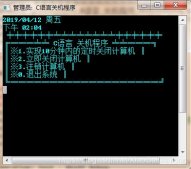本文实例讲述了C语言实现BMP转换JPG的方法。分享给大家供大家参考。具体实现方法如下:
|
1
2
3
4
5
6
7
8
9
10
11
12
13
14
15
16
17
18
19
20
21
22
23
24
25
26
27
28
29
30
31
32
33
34
35
36
37
38
39
40
41
42
43
44
45
46
47
48
49
50
51
52
53
54
55
56
57
58
59
60
61
62
63
64
65
66
67
68
69
70
71
72
73
74
75
76
77
78
79
80
81
82
83
84
85
86
87
88
89
90
91
92
93
94
95
96
97
98
99
100
101
102
103
104
105
106
107
108
109
110
111
112
113
|
/****************************************************************************名称: jpeg.c功能: linux下bmp转化为jpeg程序源代码日期: 2010.01.26注意: 编译时加“-ljpeg”(gcc -o bmp2jpg jpeg.c -ljpeg)*****************************************************************************/#include <string.h>#include <sys/types.h>#include <sys/stat.h>#include <sys/ioctl.h>#include <sys/mman.h>#include <linux/videodev.h>#include <fcntl.h>#include <unistd.h>#include <stdio.h>#include <errno.h>#include <stdlib.h>#include <signal.h>#include <sys/timeb.h>#include <jpeglib.h>#define JPEG_QUALITY 95 //图片质量int Bmp2Jpg(const char *bmp_file, const char *jeg_file, const int width, const int height){ FILE *fd; int ret; unsigned char *data; long sizeImage; int depth = 3; JSAMPROW * row_pointer; long rgb_index = 0; int i=0; struct jpeg_compress_struct cinfo; struct jpeg_error_mgr jerr; FILE *outfile; ; // Read bmp image data sizeImage = width*height*3; data = (unsigned char*)malloc(sizeImage); fd = fopen(bmp_file, "rb"); if(!fd) { printf("ERROR1: Can not open the image.\n"); free(data); return -1; } fseek(fd, 54, SEEK_SET); ret = fread(data, sizeof(unsigned char)*sizeImage, 1, fd); if(ret == 0) { if(ferror(fd)) { printf("\nERROR2: Can not read the pixel data.\n"); free(data); fclose(fd); return -1; } } //Convert BMP to JPG cinfo.err = jpeg_std_error(&jerr); //* Now we can initialize the JPEG compression object. jpeg_create_compress(&cinfo); if ((outfile = fopen(jeg_file, "wb")) == NULL) { fprintf(stderr, "can't open %s\n", jeg_file); return -1; } jpeg_stdio_dest(&cinfo, outfile); cinfo.image_width = width; //* image width and height, in pixels cinfo.image_height = height; cinfo.input_components = depth; //* # of color components per pixel cinfo.in_color_space = JCS_RGB; //* colorspace of input image jpeg_set_defaults(&cinfo); //Now you can set any non-default parameters you wish to. //Here we just illustrate the use of quality (quantization table) scaling: jpeg_set_quality(&cinfo, JPEG_QUALITY, TRUE ); //* limit to baseline-JPEG values jpeg_start_compress(&cinfo, TRUE); //一次写入 int j=0; row_pointer = malloc(height*width*3); char * line[300]; for(i=0;i<height;i++) { unsigned char * lineData = NULL; lineData = malloc(width*3); line[i]=lineData; for(j=0;j<width;j++) { lineData[j*3+2] = data[rgb_index]; rgb_index ++; lineData[j*3+1] = data[rgb_index]; rgb_index ++; lineData[j*3+0] = data[rgb_index]; rgb_index ++; } row_pointer[height-i-1] = lineData; } jpeg_write_scanlines(&cinfo, row_pointer, height); jpeg_finish_compress(&cinfo); jpeg_destroy_compress(&cinfo); for (i=0; i<height; i++) { free(line[i]); } free(row_pointer); free(data); fclose(fd); fclose(outfile); return 0;} |
希望本文所述对大家的C语言程序设计有所帮助。
















